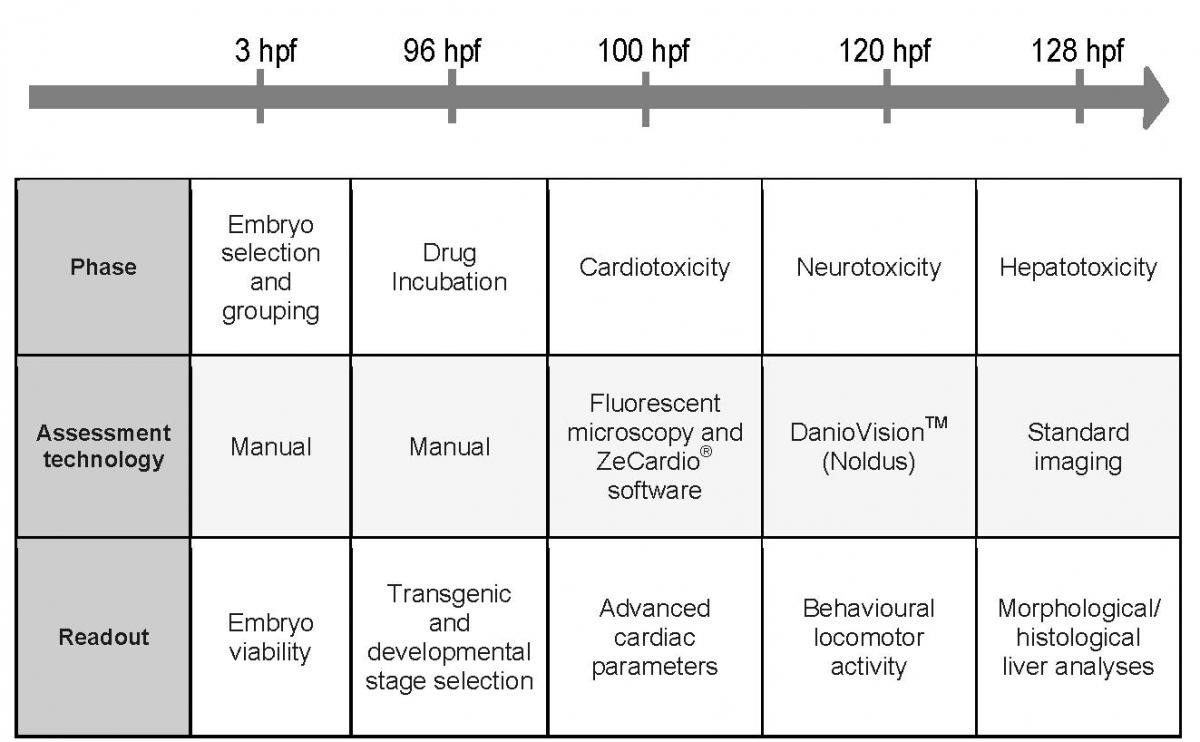ZeGlobalTox: multi-organ toxicity testing in zebrafish

At a glance
Contents
Overview
There is increasing recognition that new approaches are needed to bridge the gap between preclinical in vitro and in vivo testing to reduce costly late-stage attrition of new drugs. Pharmaceutical companies and regulatory agencies are addressing this problem by searching for novel models and introducing new standards in drug development. High-throughput zebrafish screens are becoming an important tool in the pharmaceutical industry for assessing toxicity and efficacy of new drugs. Although single organ specific toxicity assays have already been commercialised, it is not yet possible to assess toxicity in the three main organs (brain, heart and liver) in the same animal.
To address this, the company ZeClinics has developed ZeGlobalTox, a medium/high-throughput preclinical zebrafish embryo screen capable of identifying compounds with potential cardiac-, hepato- and neuro-toxicity liabilities in the same animal. The system is a quick and economical tool for assessing potential toxicities in large libraries of molecules at a morphological and functional level early in drug development. This has the potential to reduce the number of compounds entering regulatory in vivo studies and saving up to the 95% of R&D time and budget.
To maximise the potential 3Rs and commercial benefits of ZeGlobalTox, the team has validated the platform against compound sets with known preclinical and clinical toxicity data and are seeking to automate the complete procedure. Through the CRACK IT Solutions scheme, they are collaborating with two companies, Noldus and Pivot Park Screening Centre to adapt their ZeGlobalTox to advanced imaging and behavioural analysis software and automated robotic platform for a better end-user uptake.
Full details about this CRACK IT Solution can be found on the CRACK IT website.
Impact
To assess ZeGlobalTox validity, it was first necessary to optimise the experimental conditions for each of the single-organ toxicity assays. The team at ZeClinics S.L. used gold-standard drug controls were used to examine cardiovascular function, locomotor activity and liver function. This phase also provided an important opportunity to assess the utility of the software and imaging technologies developed or adopted to examine each of the specific endpoints within the combined assay.The fully optimised combined protocol (see Table 1) was validated with a set of four positive compounds and an additional group of 20 blind compounds, provided by the collaborator Pivot Park Screening Centre.

Table 1: ZeGlobalTox final procedure.
Each tested drug has been correlated to its known effects in humans, as identified in the scientific literature, and compared with the phenotype measured in the ZeGlobalTox assay. Using this analysis, it is possible to determine, by multiple parameters, the predictability of the ZeGlobalTox approach on the three main organ-specific drug toxicities from the same zebrafish larva. It is important to note that cardiotoxicity was segmented in four different phenotypes (QTc prolongation, cardiac arrest, frequency and ejection fraction), which gives this assay further relevance. Full results are shown in Tables 2 and 3.Table 1: ZeGlobalTox final procedure.
|
Cardiotoxicity |
Neurotoxicity |
Hepatotoxicity |
||||||||
|
|
Human |
|
|
Human |
|
|
Human |
|||
|
- |
+ |
- |
+ |
- |
+ |
|||||
|
- |
TN:55 |
FN:14 |
ZF |
- |
TN:11 |
FN:3 |
ZF |
- |
TN:9 |
FN:1 |
|
+ |
FP:4 |
TP:23 |
+ |
FP:2 |
TP:8 |
+ |
FP:3 |
TP:11 |
Table 2: ZeGlobalTox results for 24 compunds. Cardiotoxicity prediction has been segmented in four different phenotypes (96 predictors vs 24).
|
Assay |
Specificity |
Sensitivity |
PPV |
NPV |
|
Cardiotoxicity |
0.94 |
0.60 |
0.65 |
0.76 |
|
Neurotoxicity |
0.85 |
0.73 |
0.85 |
0.73 |
|
Hepatotoxicity |
0.75 |
0.92 |
0.79 |
0.9 |
|
ZeGlobalTox |
0.89 |
0.67 |
0.81 |
0.8 |
Table 3: ZeGlobalTox predictivity.
This validation project highlights the predictive value of the combined ZeGlobalTox assay when assessing a relatively small compound set. Further exploitation of ZeGlobalTox could have a large impact on the number of animals used in toxicity studies. A traditional in vivo single-organ test is conducted, on average, with a group of 20 rodents or dogs per tested drug, resulting in up to 60 animals being used to test neuro-, cardiac- and hepatoxicity of each drug. Using ZeGlobalTox, it is possible to reduce this number to a third, plus zebrafish is a non-protected animal when used under 5 dpf (EU Directive 2010/63/EU). The optimization of multiple physiological parameters included in ZeGlobalTox, either by using ZeCardio® software (also developed as a result of a collaboration identified through CRACK IT Solutions – see here) or adapting already available technologies, such as DanioVisionTM, from Noldus, has contributed to improving the utility and usability of ZeGlobalTox, making it easier for wider adoption of end-users.
ZeClinics is continuing to develop and expand the technology by exploring further options for automation to improve throughput and exploring the methodology as a tool for efficacy studies in the fields of neuro- and cardioprotection.
For further information visit http://www.zeclinics.com/.
Publications
Cornet C et al. (2017). ZeGlobalTox: An Innovative Approach to Address Organ Drug Toxicity Using Zebrafish. Int. J. Mol. Sci. 18(4), 864; doi:10.3390/ijms18040864.
Posters
Cornet C et al. (2016). ZeGlobalTox: An Innovative Approach to Address Organ Drug Toxicity Using Zebrafish.
